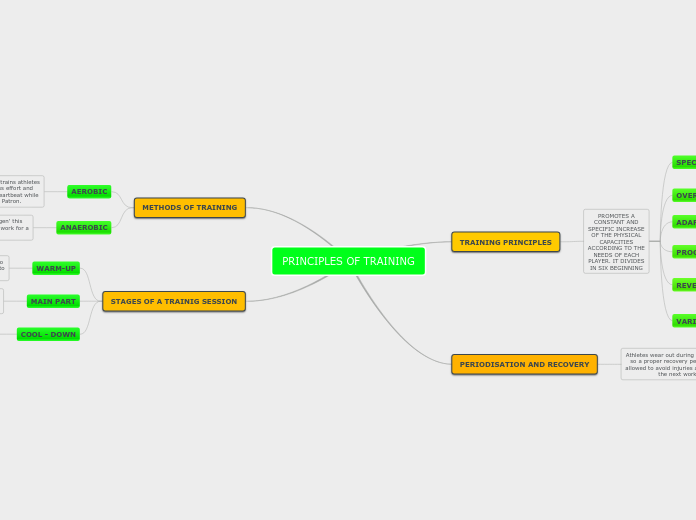PRINCIPLES OF TRAINING
TRAINING PRINCIPLES
PROMOTES A
CONSTANT AND
SPECIFIC INCREASE
OF THE PHYSICAL
CAPACITIES
ACCORDING TO THE
NEEDS OF EACH
PLAYER. IT DIVIDES
IN SIX BEGINNING
SPECIFITY
Develops the physical condition of the
muscular and energetic systems taking into
account the capabilities of Recovery and
management of training stress
OVERLOAD
The load should gradually increase in
volume and intensity for the body to adapt.
ADAPTION
The ability of the body to adapt to the
increase or decrease of physical demands.
PROGRESSION
The physical requirement must be
continuously increased in order to reach
the optimal aptitude levels
REVERSIBILITY
If the player stops training his winnings
disappear quickly so he must have a
moderately high level all year.
VARIATION
The exercises and activities must be
changed regularly to reach the maximum
level of fitness and to maintain the interest
in the training.
PERIODISATION AND RECOVERY
Athletes wear out during a hard workout,
so a proper recovery period should be
allowed to avoid injuries and be ready for
the next workout.
METHODS OF TRAINING
AEROBIC
Aerobics: 'with air or oxygen' trains athletes
to process more air with less effort and
pump more blood with less heartbeat while
maintaining a rhythmic Patron.
ANAEROBIC
Anaerobic: 'without air or oxygen' this
exercise manages a high rate of work for a
short time.
STAGES OF A TRAINIG SESSION
WARM-UP
Prepares the player for training to
continue raising his temperature to
facilitate his performance.
MAIN PART
The type of training depends on the
training and goals. Each sport uses different
energy systems.
COOL - DOWN
Is to bring the body to its natural state after
having performed an activity and this is
done by stretching.
